Boom. The shock-wave hit my chest, then again, then twice more. “We have to move quick" said Daniel, "before the dust gets here” - Welcome to the mines of Cerro Rico, Bolivia.
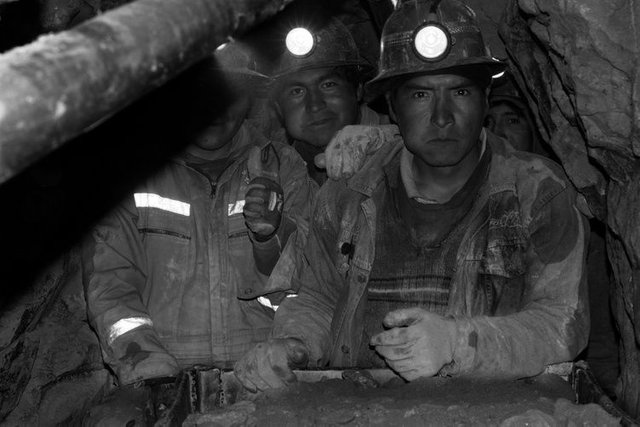
Boom. The shock-wave hit my chest, then again, then twice more. “We have to move quick" said Daniel, "before the dust gets here”.
I jump down into the pulpy sulfurous mud and we start pushing for the exit. The guys in front are straining hard with the last ton of minerals, forcing the cart along the make shift wooden rails, but the battered metal beast won't move, the rails keep coming off the track, slowing us down.
The team grunt, breathing heavy in the thin, sulfuric air, as they try to force it through. The cramped tunnel, no more than a meter high or wide is making maneuvering difficult. More hands squeeze past me to help. Eventually the brute force of 6 men gets it going again.
We make it to the exit and out into the piercing light of day, just before the dust from the dynamite blast catches up with us.
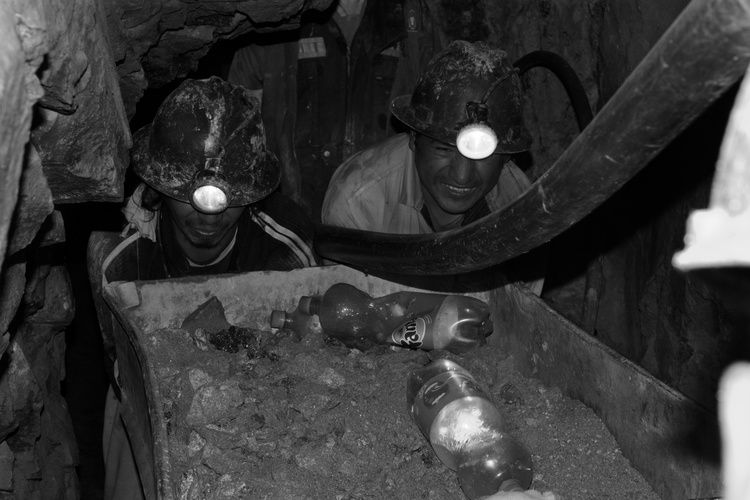
The next morning I awake at 4am, my head banging like a hungover Tanuki, arms and hands stiff as an old mountain goat, with a volcanic stomach. I am coughing up black sputum and my chest is in the the grip of a slow, twisting vice. It felt like flu, but I knew it wasn’t. It was the result of the end of my first (and only) full day’s work in the mines of Kari Kari, part of the infamous Cerro Rico and Potosi mountain range.
26 hours earlier I had made my way with Daniel to his father’s house to meet with him and his crew. After a quick cup of coco de mate the 10 of us squeezed into his old Mitsubishi Pajero and began our ascent up the mountain, belching black exhaust as we followed the old underground waste river to the sound of 60’s pop and rock.
A quick stop at the miners market to collect supplies of coca leaves, dynamite and Fanta and we continued up and around the red mountain and cut across the Potosi plateau, 20 kilometres north-eastwards.
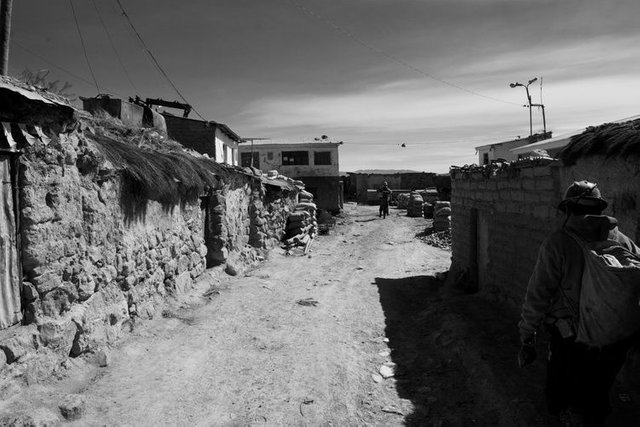
Arriving at the mine, which Daniel’s father has hired from a local farmer (who has realised there is more money to be made from renting land to be excavated than farming pigs). We stumble into the hand-built rocky shack next to the entrance for a quick breakfast of vegetable soup and plain chicken with white corn, followed by coca leaves dessert. Miners eat the leves to keep them alert and stave off hunger while they work. The next 6 hours there would be no more food, just coca leaves and sweet, sickly, orange pop.
After half an hour of consistently adding more leaves to the ball in my cheek the miners joke my Spanish is getting worse, it's true, my mouth and tongue were completely numb.
Outside, woman palliri’s (hand pickers) sorted through discarded debris, removing unwanted rocks and filtering out the last remnants of minerals, creating more space for the next batch. They are not allowed to work in the mine.
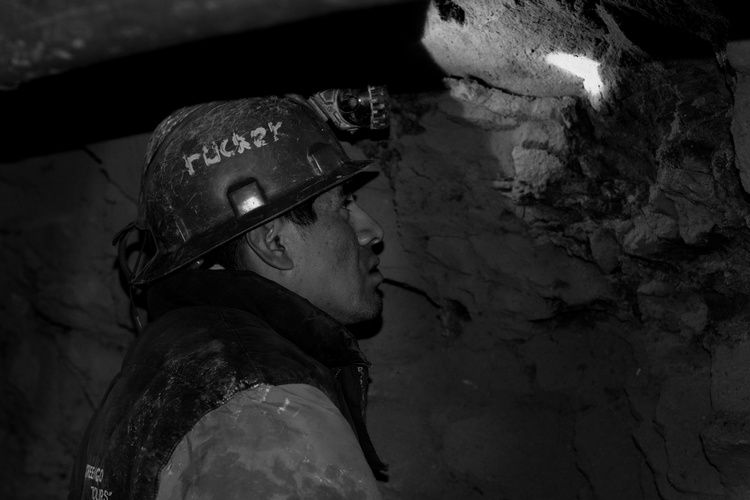
We turn on our helmet lamps and enter the shaft, This is a new mine so it's not as deep or hot as the ones I visited in Cerro Rico the day before. Daniel’s father hopes there are more minerals here. Cerro Rico has been mined to death, literally. Over 400 years of exploitation means the mountain is nearing collapse and the silver rush which fueled the Spanish empire is long gone. Now its mostly tin, zinc and lead.
Conditions for "co-operative" miners haven't changed much since the Spanish first forced native Indian and African slaves to pillage mother earth. They might have better lamps and slightly more protective clothing, but that's it. On the other side of the mountain the open pit San Cristobal private mine (the world’s sixth-largest producer of zinc and third-largest producer of silver) are doing things differently. They have bulldozers, electricity and pneumatic drills, and process approximately 50,000 tons of rock a day.
Pressing on for 1/2 a mile we reach a vertical shaft leading downwards with a damp rickety makeshift ladder made of roughly nailed planks, hung by rope from a supporting beam wedged between previously blasted rocks. It doesn’t look safe to me, but then nothing in this subterranean world ruled by El Tio looks safe.
“Ok, lets go” say’s Daniel. The ladder is slightly rotten, covered in grey slimy clay. I watch him disappear into the darkness and catch my breath before following. I don’t know how deep it goes and pray that my rock climbing skills will keep me safe. After about 10 meters I see another diagonal plank, precariously balanced on the last step of the ladder leading into an abyss. I place my foot on it, it slips, and I hear Daniel shout.
“No, No, turn around, you’ll fall if you go that way, you have to lower yourself and slide down on your bum.”
My heart is pounding (no thanks to the coca leaves), I can’t see the bottom and I start to think that maybe this is a bad idea. But I’m here now, these guys do this every day I say to myself, I can do this.
I follow Daniel’s instructions and slide down the plank onto the dusty shelf below. Breathing heavily I look below. I still can’t see the bottom, but at least for the moment I am on solid ground, a quarter of a mile below the surface, 4,100 meters above sea level. I am pretty sure this is not a natural place for human beings.
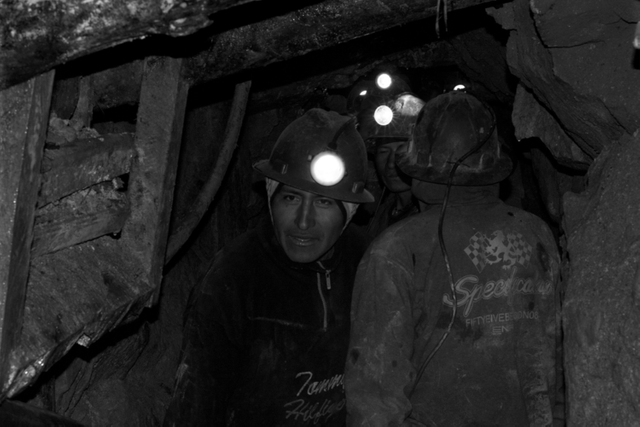
We set to work. Pickaxing bedrock, filling and hoisting rubber baskets and delivering wagons to the surface. It’s hot, hard labor.
This continues for the next 6 hours, apart from one 15 minute stop at 2pm to chew some more coca leaves and drink some of the sugary fake orange, or pure refined alcohol if you so choose, which most of them do. They believe drinking pure alcohol keeps them safe and pleases El Tio (the devil that rules the underground) and shows respect for Pachamama. Ronald, an ex-miner now tourist guide tells me "the miners drink to say thank you to the mountain, because the mountain is still alive and the mines are supporting their families".
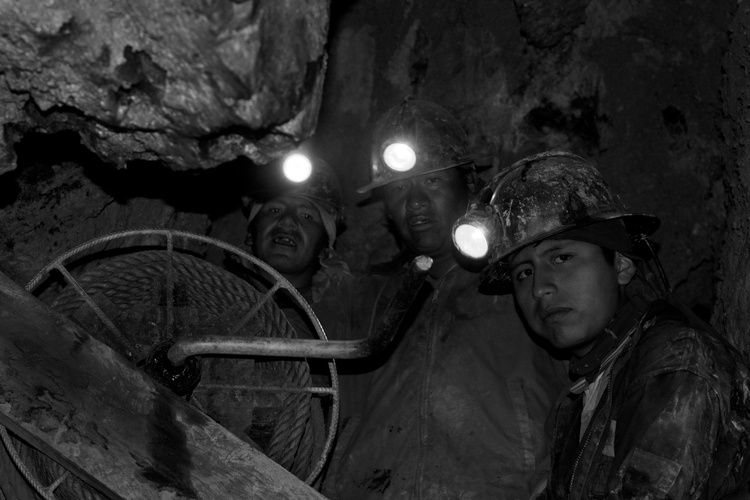
It turns out I am not the only rookie on the team today. It is also Ishmael's first day, he is 15 and puts me to shame. Loading and running the wheelbarrow with athletic prowess. It's not unusual for children as young as 12 to work in the mines to support their families. Compared to other work (of which there is very little) the salary of £20 a week is a good one. I can't help feel a pang of western guilt. Tomorrow I will be gone, but this will most likely be Ishmael's daily routine for the rest of his life, unless he learns English and then maybe he can become a tourist guide like Ronald, showing gringos like me around Cerro Rico, if it's still standing that is, and he hasn't died from black lung or a cave in.
I ask Daniel what they will do when there's nothing left to mine.
"We will have to leave." he says; "Bolivia has to find another economy but no one knows how. Mining is all we know."
The future for Potosi is bleak. When the minerals run out there will be nothing left, just the spirit of El Tio and the shadow of a ghost town that was once one of the richest in the world. It seems, ironically, there will be no silver lining for this town.
D007 - If you enjoy my work follow me @dylan007
What an interesting experience!
Thanks to @sanmi, this article was resteemed and highlighted in today's edition of The Daily Sneak.
Thank you for your efforts to create quality content.
HI @sneakyninja and thanks @sanmi for highlighting my article in The Daily Sneak Knowing that people enjoy my writing and want to share it and that good quality content really does get rewarded on Steemit really means a lot to me, especially as I am a real newbie here, and will encourage me and all steemians to keep making great quality content. New article coming today! Thanks again guys.
Keep up the great work!
Thanks! I just posted my first food article about the invasive lionfish and how to cook with it. It's called Fighting Lions It would be great if you have time to take a read and post a comment. Have a great day - @dylan007
Upvoted on behalf of @thehumanbot and it's allies for writing this great original content.
Great Original Works are rewarded by top Curators, refer posts from my Step-Brother @humanbot for more details.If you like this initiative, you can follow me in SteemAuto and upvote the posts, that I upvote.
And remember to do some charity when you are rich by contributing to me. Check out my Introduction Post for more details. If you have any concerns or feedback with my way of operation, raise it with @sanmi , my operator who is freaking in Steemit chat most of the time.
Hi @thehumanbot thanks so much for upvoting and liking my content. I have followed you to learn more about what you do. Have a great day.